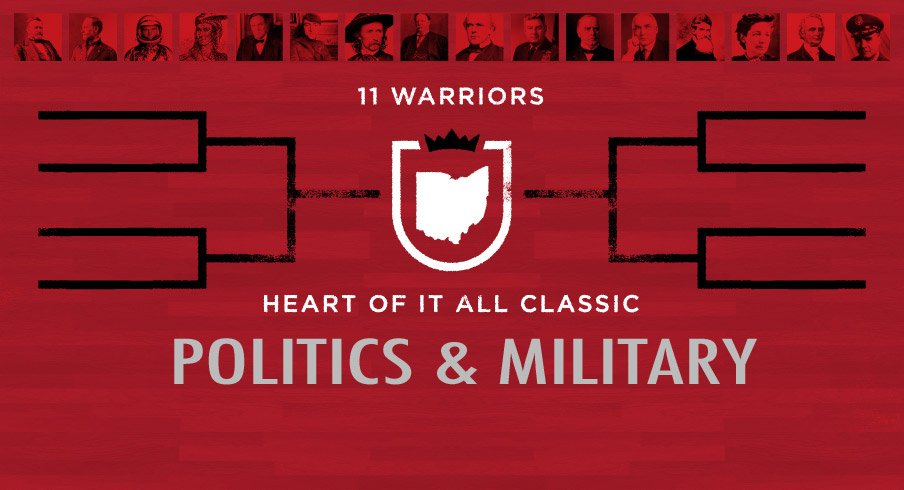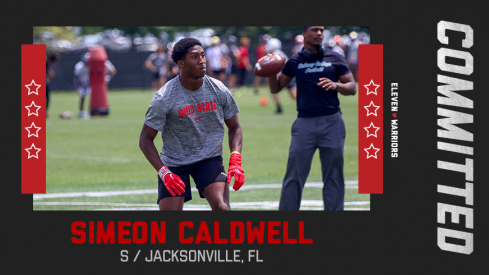Ohio State adds another top-100 safety as Simeon Caldwell commits to the Buckeyes.
We now move on to the Politics and Military region, lorded over by President Ulysses S. Grant and General William Tecumseh Sherman. In what is probably the most stacked region of this tournament, the winner will be forged in fire, blood and brimstone and must be considered the favorite to win the tournament outright.
If you need a refresher, you can read up on the full rules and seedings. Here's your printable bracket (PDF).
Winners will be announced on Friday night with the second round of voting opening up Saturday morning.
#1 Ulysses S. Grant vs. #16 Paul Tibbets
Ulysses S. Grant: Born and raised in Ohio, the S. stood for "Nothing." After being nominated at 17 by a local congressman for a position at the United States Military Academy at West Point, Grant would rise through the military ranks to Commanding General of the United States Army.
Under the lead of Grant, the Union smashed the Confederacy in a decisive victory. Grant was on hand when General Robert E. Lee bent his knee and surrendered at Appomattox, securing the B1G's first and only Civil War championship over the SEC.
Not satisfied, Grant rode his military success to becoming the the 18th President of the United States. Known for a steel liver and some shady political appointments, he oversaw reconstruction of the South, expanded civil rights and fought the Ku Klux Klan.
Paul Tibbets: Paul Tibbets was an Air Force Brigadier-General most-known for being the pilot of the Enola Gay.
With Japan on the ropes and having endured a vicious fire-bombing campaign, the U.S. was eyeing a costly land-invasion. Instead, US elders went for the freshly-minted atomic option.
On August 5, 1945, Brigadier-General Paul Tibbets personally selected the Enola Gay — he named it after his mother — off the B-29 Superfortress assembly line. The next day, he would fly the Enola Gay — armed with America's first atomic bomb, code-named "Little Boy" — and bomb Hiroshima, killing between 60,000-80,000 people.
Three days later, Nagasaki was atomically bombed. On August 15, 1945 the Japanese officially surrendered to the Allied Powers. Though horrific, the atomic bombings are thought to have saved thousands of American lives.
#2 William Tecumseh Sherman vs. #15 John Rankin
William Tecumseh Sherman: Possibly the strongest No. 2 seed in the whole tournament, the Scourge of Georgia was born in Lancaster in February of 1820.
Sherman was commissioned as a colonel of a then-unraised, volunteer brigade. His ascension through the ranks of the US military culminated with his appoint as Ulysses S. Grant's successor as Commanding General of the United States Army in 1869.
Sherman would etch his name into American lore by dealing the decisive knock-out blow to the Confederate Army. Originally charted to aide in the pursuit of Robert E. Lee's retreating forces, Grant was convinced by Sherman to allow him to break towards Georgia and bring the Peach State to heel through total war. Sherman was convinced he could "make Georgia howl," and he wasn't wrong.
He sliced through Georgia, burning everything that stood in his way. After sacking Savannah, Sherman gifted it to President Lincoln on Christmas Day in 1864. He then turned his attention to the Carolinas and burned everything of military value during what history would call his "March to the Sea."
John Rankin: Rankin is a famous abolitionist and Presbyterian minister. Upon moving to Ripley in 1822, Rankin became one of the most active conductors on the Underground Railroad. Harriet Beecher Stowe, the author of Uncle Tom's Cabin, was even influenced by Rankin's devout work.
It's speculated he helped thousands of runaway slaves gain their freedom while risking imprisonment, and his 1826 anti-slavery letters to his slave-owning brother — some of his first published work in Ripley, a town then-known for brawls and shootings — were the first written anti-slavery views west of the Appalachians. Rankin eventually convinced his brother, who moved to Ohio in 1827 and freed his slaves.
#3 John Glenn vs #14 Victoria Woodhull
John Glenn: Cambridge's John Glenn is a former Marine Corps pilot, US Senator and astronaut. He is the only surviving member of the Mercury Seven, the elite pilots trained by NASA to be America's first astronauts.
In 1962, aboard Friendship 7, Glenn became the first American to orbit the Earth. He was rightfully crowned as a national hero.
Two weeks after President Kennedy was assassinated, Glenn left NASA and returned to Ohio to run for Senate, an office he held from 1974 to 1999.
Victoria Woodhull: Born in Homer in 1838 nearly a century before women got the right to vote, Victoria Woodhull was a premier leader and thinker in the early women's suffrage movement.
A proponent of free love, Woodhull believed women had the right to marry, divorce and bear children without government interference. In 1872, she became the first woman candidate for President of the United States, running under the Equal Rights Party. In 2001, she was posthumously inducted into the National Women's Hall of Fame.
#4 Tecumseh vs. #13 John Brown
Tecumseh: Born on the banks of the Scioto River in 1768, Tecumseh was the first tournament entrant to lay down Ohio roots. Forged in the fires of the American Revolutionary War and Northwest Indian War, Tecumseh knew battle from an early age.
He was a Shawnee Native American who formed his own Native confederacy to rise up in resistance of the United States' expansion during Tecumseh's War and the War of 1812.
Allied with the British and aiding in the capture Fort Detroit, Tecumseh's resistance to American expansion proved futile when he was slain by American forces in the Battle of the Thames in 1813. He remains a Native American icon and a folklore legend to this day.
John Brown: John Brown is one of America's most legendary abolitionists for his thinking armed insurrection was the only way to combat the institution of slavery.
Born in Connecticut, Brown's family would move to Hudson in 1805. After a stint back in Connecticut for college, Brown returned to Ohio and began work as a tanner. It looked like that might be his fate, but after the murder of Elijah P. Lovejoy, Brown famously declared: "Here, before God, in the presence of these witnesses, from this time, I consecrate my life to the destruction of slavery!"
After whetting his appetite by leading raids during the Bleeding Kansas saga, Brown's anti-slavery work culminated with the 1859 raid on Harpers Ferry, a federal armory. Although the raid was successful, Brown's men abandoned him and he was captured by federal and militia forces lead by Robert E. Lee. He was hanged shortly thereafter, but his death was an instrumental force causing the Civil War.
#5 CLarence Darrow vs. #12 Warren G. Harding
Clarence Darrow: Darrow was born in rural northeastern Ohio (Kinsman Township) to an ardent abolitionist and women's suffragette.
After stops at Allegheny College and Michigan Law School — he graduated from neither — Darrow was admitted to the Ohio Bar in 1878. He would rise to become one of the most prominent trial lawyers and free thinkers of the 19th century.
Famous for defending the teenage thrill-killers who murdered a 14-year-old boy, Darrow would become most renowned for his owning of the SEC in defense of John T. Scopes in the "Scopes Monkey Trial." (His opponent was a small historical figure you may have heard of: William Jennings Bryan.)
Warren G. Harding: The 29th President of the United States, Warren G. Harding rose from small-town newspaper peddler to the Leader of the Free World while rarely having to leave the confines of his front porch.
Born in Blooming Grove in 1865, Warren came to his eternal home, Marion, after graduating from Ohio Central College at the age of 16. After buying a raggedy newspaper operation with his friends (and winning full control in a back-room poker game), Warren turned The Marion Star into the official paper of county record, married the daughter of his arch-rival and began his career in politics.
In 1919 — the first year women could vote — Warren G. Harding won the presidential election in an historical landslide. An affable fellow rumored to favor bacchanalian White House-orgies and multiple mistresses, he ushered the American economy into an era of unseen prosperity before mysteriously dying in 1923. While Warren's presidential cabinet was riddled with corruption — see the Teapot Dome scandal — it has never been proven Warren was complicit in any wrongdoing.
#6 Eddie Rickenbacker vs. #11 William McKinley
Eddie Rickenbacker: Fast Eddie was born in Columbus in 1890, and rose to the rank of Air Force Major.
Rickenbacker enlisted in 1917, but his desires to pilot an airplane were quashed by his superiors due to Rickenbacker's lack of formal education and his more-valued mechanical skills.
When Rickenbacker showed he had a qualified replacement, the Air Force assigned him to the 94th Aero Squadron. It turned out to be a good decision. In April of 1918, Rickenbacker shot down his first enemy airplane.
When he hung up his fightin' mittens, Rickenbacker flew more than 300 combat hours. His 26 confirmed aerial victories was a United State military record until World War II. For his bravery, Rickenbacker was awarded the Medal of Honor, the country's highest honor. Columbus' Rickenbacker Air Force Base bears his name today.
William McKinley: Born in Niles in 1843, William McKinley's political career culminated with being elected as the nation's 25th President in 1897. He oversaw America's victory in the Spanish-American War and is the last president to have served in the Civil War.
A staunch protectionist, McKinley rose tariffs to protect American industry. He was also a fierce defender of the gold standard and pursued annexation of Hawaii.
McKinley's policies were popular enough to see him re-elected for a second presidential term in 1900. Shortly after his second inauguration in March 1901, however, McKinley was shot by anarchist Leon Czolgosz. Initially thought to have survived the attack, McKinley succumbed to unforeseen intestinal gangrene.
#7 George Custer vs. #10 Curtis LeMay
George Custer: Like all legends claimed by Michigan, George Armstrong Custer was born in (New Rumley) Ohio (in 1839). He has the dubious honor of ranking last in his graduating class at West Point.
Poor academic career aside, Custer rose to Brevet Major General and was a calvary commander in the Civil War. His troops played a significant role in the Appomattox campaign, and Custer was on hand to watch Robert E. Lee bend the knee to Ulysses S. Grant.
After the Civil War, Custer was dispatched out west squelch Native America rebellion to U.S. expansion. He was quite successful, but his accolades were all washed away after Custer's Last Stand in Bighorn, Montana, in 1876, where a coalition of Native American forces slew Custer and all of his men.
Curtis LeMay: Old Iron Pants began his life in Columbus in 1906. When he died 83 years later, "Bombs Away" LeMay would be one of the most controversial figures in American military history.
Rising to the rank of Four-Star Air Force General during World War II, LeMay designed the effective (and very controversial) systematic bombing against Japanese cities and "Operation Starvation," a minelaying campaign in Japan's waterways in order to disrupt Japanese shipping.
He served as Air Force Chief of Staff from 1961 until his retirement in 1965. He also ran under the American Independent Party flag for Vice President of the United States on a ticket with George Wallace in 1968.
#8 William Howard Taft vs. #9 Salmon P. Chase
William Taft: Born in Cincinnati, Taft would become one of the most prominent politicians of his era. He is the only person in United States history to serve as President of the United States and as Chief Justice of the Supreme Court.
Taft's accomplishments were numerous in his only term as President: he trust-busted powerful corporations, oversaw civil service reform, improved the post office and passed with the Sixteenth Amendment to the US Constitution.
Owner of one of the silkiest mustaches in presidential history, Taft also has the dubious honor of being the only US President fat enough (5'11", 335 lbs) to allegedly get stuck in a bathroom tub.
Salmon P. Chase: Raised and partially educated in Ohio, Salmon P. Chase was a former Ohio Senator and 23rd Governor of the Buckeye State. He served as U.S. Treasury Secretary under President Abraham Lincoln. He was also the sixth Chief Justice of the United States Supreme Court and presided over President Andrew Johnson's impeachment trial.
A staunch abolitionist, Chase was one of the first to articulate the "slave power conspiracy," even before President Lincoln. Chase believed there to be a conspiracy of southern slave owners to seize control of the federal government and "block liberty" before the first shot of the Civil War had even been fired.
Chase also has the honor of being the face of the 10,000 dollar bill, the largest bill to ever be publicly circulated in the United States.


